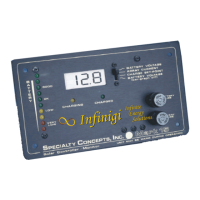PROBLEM CONDITIONS:
5. SYSTEM IS NOT SIZED CORRECTLY - The system batteries will tend to be under-charged if the
solar array is too small, or if the battery bank is too small, or if the usage is too high. Some
systems contain small hidden loads that can slowly draw down the battery.
6. PROBLEMS WITH SOLAR PANELS - Solar panel output is dependent upon the amount of sun-
energy reaching the panel. This can be seriously affected by the angle of the panel and sun (as in
winter months), minor shading, high level haze (barely visible) and dust on the panel. At the time of
installation, a solar array can have an incorrect series-parallel configuration for the proper system
voltage and current. A panel can also become less productive or defective over time. TEST:
Disconnect the MARK/(15,20) from the panel, and measure the voltage at panel(+) and panel(-). In
sunny conditions, this should be 18-24 volts. A lower value may indicate a problem with the panel.
To check the panel’s current output, contact a local solar dealer.
7. PROBLEMS WITH BATTERIES - At the time of installation, a battery bank can have an incorrect
series-parallel configuration for the proper system voltage and current. A battery can also go bad
and unable to maintain a charge. If the battery is going bad, a little charging or discharging will cause
a large change in the battery voltage. Also, a shorted battery cell will cause the battery to gas heavily
and the system will charge constantly will no notable increase in voltage. If the condition of the
battery is suspect, a battery capacity test is recommended.
8. BAD CONNECTION: PANEL - The solar panel connection to the controller may be weak or
completely out. Problems can be found at the MARK/(15,20) connection (ARRAY(+) & ARRAY(–)
terminals), both panel connections (“+” or “–”), the Array Fuse on MARK/(15,20) (either blown or
defective), or fuses and unsoldered crimp connectors in these lines. Also, wire that is too small for
the length of the run may cause a problem. Refer to INSTALLATION INSTRUCTIONS, step #17:
CHECK FOR VOLTAGE DROP (Page 8).
9. BAD CONNECTION: BATTERIES - The battery connection to the controller may be weak or
completely out. The MARK/(15,20) needs to read an accurate battery voltage to regulate the
charging correctly. Therefore, you need to minimize the voltage drop from the battery. Problems
can be found with the MARK/(15,20) connection (BATT(+) and BATT(–) terminals), both battery
terminals (“+” or “–”), the Battery Fuse on MARK/(15,20) (either blown or defective), or fuses and
unsoldered crimp connectors in these lines. Also, small wire or incorrect wiring may cause a voltage
drop. Refer to INSTALLATION INSTRUCTIONS, step #12: MARK/(15,20) CONNECTION (Page 7)
and step #17: CHECK FOR VOLTAGE DROP (Page 8).
10. CONTROLLER MISWIRED - This may include reversing the polarity from the panels or batteries,
or switching the array and battery connections. This may also include a deviation from the wiring
instructions, such as using a jumper across the BATTERY(-) & ARRAY(-) connections or by having
your battery(–) connection run to a frame or chassis and not the actual battery itself. Refer to
INSTALLATION INSTRUCTIONS, step #12: MARK/(15,20) CONNECTION (Page 7).
11. INCORRECT VOLTAGE SET-POINT - The MARK/(15,20) may be functional but the charge
termination set-point may not be correct for your batteries. The factory set-point is 14.4 volts and is
designed to work for the majority of batteries. Set the front panel switch position to “CHARGE
SET-POINT” and verify set-point. Refer to the ‘CHARGE SET-POINT ADJUSTMENT” section
(Page 11) and consider if an adjustment may be necessary.
12. SYSTEM NOISE - The MARK/(15,20) can be affected by electrical noise from a converter or
inverter. This will not affect the charging function but will cause erratic meter readings. If the
MARK/(15,20) is connected to a buss that is connected to a converter, try connecting the
MARK/(15,20) directly to the battery instead.
13. CONTROLLER DEFECTIVE - The MARK/(15,20) may no longer be functional. A defective unit can
overcharge the battery or stop all charging. A faulty unit can not drain a battery. It may have been
exposed to high voltage or current, reverse polarity from the batteries or other wiring problem.

